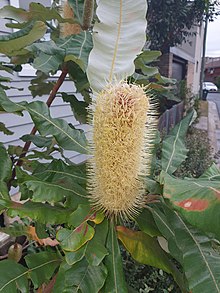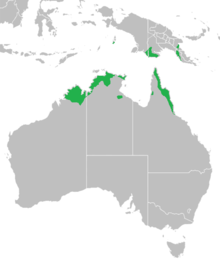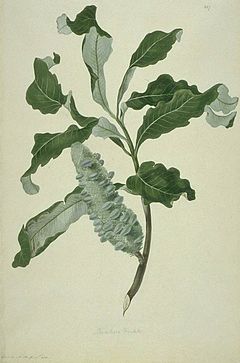Banksia dentata
| Banksia dentata | |
|---|---|

| |
| Scientific classification | |
| Kingdom: | Plantae |
| Clade: | Tracheophytes |
| Clade: | Angiosperms |
| Clade: | Eudicots |
| Order: | Proteales |
| Family: | Proteaceae |
| Genus: | Banksia |
| Species: | B. dentata
|
| Binomial name | |
| Banksia dentata L.f.[2] | |

| |
| Range across northern Australia, southern New Guinea and Aru Islands (Trangan) | |
| Synonyms[2] | |
| |

Banksia dentata, commonly known as the tropical banksia,
Banksia dentata is one of four Banksia species collected by Sir
Description
The tropical banksia is generally a small tree which grows to around 4 m (13 ft) or sometimes up to 7 m (23 ft) tall,[4] with a rough stocky trunk, spreading crown,[5] and crooked branches.[6] The dark grey bark is not flaky but tesselated in texture and appearance.[5][6] Initially covered in reddish hair that wears away, branchlets become smooth and grey with age. The large green leaves are scattered along the stems, and more crowded at the branchlet tips. They are 9–22 cm (3.5–8.7 in) long and 2–9 cm (0.79–3.54 in) wide, obovate in shape with mucronate tips. The dentate (toothed) margins are lined irregularly with 0.1–1.3 cm (0.039–0.512 in) long teeth, separated by u-shaped sinuses. The leaves are undulate (wavy) with white undersurfaces, the midrib raised underneath and depressed above. The cylindrical yellow inflorescences (flower spikes), arise from one- to three-year-old branches.[5] Appearing between November and May, they are 10 to 13 cm (3.9 to 5.1 in) high and 5 to 10 cm (2.0 to 3.9 in) wide. Newly opened flower spikes smell like corn.[6] All flower parts are pale yellow; the perianth is 2.5–3.2 cm (0.98–1.26 in) long, including a 0.5 cm (0.20 in) long limb. After anthesis, the pistil is 3.1–4.6 cm (1.2–1.8 in) long. Flower parts soon fall off ageing spikes, which develop into irregular-cylindrical infructescences. The oval follicles are 1.5–2 cm (0.59–0.79 in) long, 0.4–0.8 cm (0.16–0.31 in) high and 0.5–0.8 cm (0.20–0.31 in) wide. Pale green and furry when young, they become smooth and pale brown with age. The follicles open spontaneously with maturity.[5] They contain two seeds each, between which lies a woody dark brown separator of similar shape to the seeds. Measuring 1.8–2.1 cm (0.7–0.8 in) in length, the seed is obovate, and composed of a dark brown 1.1–1.4 cm (0.4–0.6 in) wide membranous 'wing' and obovate seed proper which measures 1.0–1.2 cm (0.4–0.5 in) long by 0.5–0.8 cm (0.2–0.3 in) wide. The seed surface can be smooth or covered in tiny ridges.[5]
The bright green cotyledons are obovate, measuring 1.6–1.9 cm (0.63–0.75 in) long by 0.8–1.1 cm (0.31–0.43 in) wide. At the base of each are two pointed auricles around 1.5 mm (0.059 in) long. The cotyledons arise from a 3–4 mm (0.12–0.16 in) high smooth hypocotyl that is 1–1.5 mm (0.039–0.059 in) in diameter. The subsequent seedling leaves are opposite initially, arising 3–4 mm above the cotyledons. Each is roughly linear in shape, measuring 2.5–2.7 cm (0.98–1.06 in) long and 0.4–0.5 cm (0.16–0.20 in) wide, with two to three serrations ("teeth") on the upper quarter to third of the leaf margin's length. The leaf undersurface is covered with white hair. Successive leaves become more obovate and are 3–7 cm (1.2–2.8 in) long and 0.8–1.2 cm (0.31–0.47 in) wide, with dentate margins and mucronate tips. Seedling stems are hairy.[5]
Taxonomy
Specimens of Banksia dentata were collected from the vicinity of the
In 1870,
In 1891,
Commonly known as the tropical banksia,
Placement within Banksia
The current
- Genus Banksia
- Subgenus Isostylis
- Subgenus Banksia
- Section Oncostylis
- Section Coccinea
- Section Banksia
- Series Grandes
- Series Banksia
- Series Crocinae
- Series Prostratae
- Series Cyrtostylis
- Series Tetragonae
- Series Bauerinae
- Series Quercinae
- Series Salicinae
- B. dentata – B. aquilonia – B. integrifolia – B. plagiocarpa – B. oblongifolia – B. robur – B. conferta – B. paludosa – B. marginata – B. canei – B. saxicola
Since 1998, American botanist
Distribution and habitat

Across northern Australia, Banksia dentata has been recorded as far west as the
Banksia dentata generally grows on sandy soils in savanna woodland or shrubland,[4] along freshwater swamps,[6] watercourses, floodplains or other seasonally wet areas. It has also been found on rocky outcrops, of quartzite or sandstone,[5] to an elevation of around 500 m (1,600 ft) in Australia,[4] and up to 1,200 m (3,900 ft) in New Guinea.[30] In New Guinea it is restricted to areas which have a distinct dry season.[30]
Banksia dentata is often found with Melaleuca and Pandanus species.[30] On Cape York, it is a dominant component in a low scrub known as "wet desert" due to its resemblance to arid scrub yet occurring in a monsoon climate. On phosphorus-poor soils, Banksia dentata is found with Melaleuca saligna and Thryptomene oligandra.[32] On Melville Island it is a dominant component of Banksia low woodland, forming part of a 3–6 m (9.8–19.7 ft) high canopy with Melaleuca viridiflora; the understory is composed of sedges such as Fimbristylis, Sorghum intrans, Eriachne, Germainia grandiflora and the restiad Dapsilanthus spathaceus, as well as suckering shrubs Lophostemon lactifluus and Syzygium eucalyptoides. This community grows in wet areas, with a grey topsoil with high moisture and gravel content but low sand.[29]
Ecology
Banksia dentata responds to bushfire by resprouting from its woody lignotuber although, unlike other members of the Salicinae, it lacks dormant buds at its base. It was described by amateur botanist and banksia enthusiast Alf Salkin as resembling an "upturned parsnip".[33] Plant communities where it is found are subject to periodic bushfires, and it can become more dominant if fires occur often.[30]
Salkin had noted that its tropical position might mean that B. dentata was a key species in the transition from rainforest to open habitat in the ancestry of the genus. One adaptation to a drier sunnier climate was a thick intermediate layer under the epidermis in the leaf architecture. This layer, the hypodermis, contains large vacuoles that are filled with a phenolic compound, and seems to serve to reduce the intensity of sunlight reaching the mesophyll.[34]
Numerous nectar-feeding insects are attracted to the flower spikes, which in turn attract honeyeaters, silvereyes and sunbirds, many of which consume both nectar and insects.[30] The sugar glider (Petaurus breviceps) forages among the flower spikes and is a probable pollinator.[9] The common blossom bat (Syconycteris australis) feeds on nectar.[35] B. dentata has been recorded as a host plant for the mistletoe species Amyema benthamii, Decaisnina angustata and D. signata.[36]
Cultivation

The tree's gnarled bark, large green leaves, and yellow flower spikes are attractive horticultural features.
Banksia dentata is used as a nectar source in the honey bee industry.[39] Aboriginal people in the Northern Territory would light old seed cones and use them as firebrands, these lasting for up to two hours.[42] The nectar was consumed by indigenous people.[6] A hot smoking flower spike was used to cauterise leprosy sores, and people suffering from diarrhea would squat over smoking cones in the hope this would relieve their symptoms.[6] The thin woody spikes that did not develop follicles were used as nasal ornaments by aboriginal women, and flower spikes were used as combs.[9]
References
- ^ George, A., Keighery, G. & Atkins, K. 2020. Banksia dentata. The IUCN Red List of Threatened Species 2020: e.T112521627A113306531. https://dx.doi.org/10.2305/IUCN.UK.2020-2.RLTS.T112521627A113306531.en. Accessed on 01 September 2023.
- ^ a b "Banksia dentata". Australian Plant Census. Retrieved 22 April 2020.
- Department of Biodiversity, Conservation and Attractions.
- ^ ISBN 978-0-644-07124-6.
- ^ S2CID 196677407.
- ^ ISBN 978-1-876334-67-3.
- doi:10.5962/p.310430.
- Linnaeus, Carolus, the Younger (1782). Supplementum Plantarum. Brunsvigae (Braunschweig, Germany): Orphanotrophei. Archived from the original on 25 July 2011.)
{{cite book}}: CS1 maint: multiple names: authors list (link - ^ ISBN 978-0-207-17277-9.
- ^ Brown, Robert (1810). Prodromus Florae Novae Hollandiae et Insulae Van Diemen. London, United Kingdom: Taylor.
- ^ Meissner, Carl (1856). "Proteaceae". In de Candolle, A. P (ed.). Prodromus Systematis Naturalis Regni Vegetabilis, Pars Decima Quarta. Paris, France: Sumptibus Victoris Masson.
- ^ Bentham, George (1870). . Flora Australiensis: Volume 5: Myoporineae to Proteaceae. London, United Kingdom: L. Reeve & Co. pp. 541–62.
- ^ Kuntze, Otto (1891). Revisio generum plantarum. Vol. 2. Leipzig: Arthur Felix. pp. 581–582.
- ^ Britten, James (1905). Banks, Joseph; Solander, Daniel C. (eds.). Illustrations of Australian plants collected in 1770 during Captain Cook's voyage round the world. Vol. 3. London, United Kingdom: Printed by order of the Trustees of the British Museum. p. 84.
- JSTOR 4107078.
- JSTOR 4111642.
- ^ ISBN 978-0-643-06454-6.
- ^ "Savannah woodlands – the lowlands". Parks Australia: Kakadu National Park. Jabiru, Northern Territory: Commonwealth of Australia. 21 November 2012. Archived from the original on 29 January 2013. Retrieved 2 December 2012.
- ISBN 978-90-272-3040-9.
- ISSN 0729-4352.
- ^ Bailey, Frederick Manson (1913). Comprehensive Catalogue of Queensland Plants. Brisbane, Queensland: A. J. Cumming, government printer. p. 455.
- ^ Salkin (1979), p. 161.
- .
- ^ Salkin (1979), p. 163.
- doi:10.1071/SB97026.
- PMID 21665734.
- doi:10.1071/SB04015.
- doi:10.1071/SB06016.
- ^ .
- ^ a b c d e f Sleumer, Hermann (1956). van Steenis, C.G.G.J. (ed.). Flora Malesiana. Series I, Seed plants. Vol. 5. Jakarta, Indonesia: Noordhoff-Kolff. pp. 205–06.
- .
- ^ Rhind, Peter Martin (2010). "Plant Formations in the Queenslandian BioProvince" (PDF). Archived from the original (PDF) on 4 March 2016. Retrieved 2 December 2012.
- ^ Salkin (1979), p. 154.
- ^ Salkin (1979), p. 162.
- PMID 22567292.
- ^ Downey, Paul O. (1998). "An inventory of host species for each aerial mistletoe species (Loranthaceae and Viscaceae) in Australia" (PDF). Cunninghamia. 5 (3): 685–720. Archived from the original (PDF) on 26 April 2012.
- ^ Radke, Peter (August 2003). "Growing Banksias in tropical North Queensland". Yuruga – Australian Native Plant Specialists. Walkamin, Queensland: Yuruga Nursery Pty Ltd. Archived from the original on 19 April 2013. Retrieved 10 November 2012.
- ^ Salkin (1979), pp. 159–60.
- ^ ISBN 978-1-876473-68-6.
- ISBN 978-0-643-09298-3.
- ^ Miller, Philip (1835). The Gardeners Dictionary (Ninth ed.). London, United Kingdom: G. Henderson. p. 588.
- ISBN 978-1-877058-51-6.
Cited text
- Salkin, Abraham Isaac (Alf) (1979). "Variation in Banksia in Eastern Australia". (MSc thesis). Clayton, Victoria: Monash University.
External links
- "Banksia dentata L.f." Flora of Australia Online. Department of the Environment and Heritage, Australian Government.
 Works related to Supplementum Plantarum/Species/Tetrandria/Monogynia#Banksia dentata at Wikisource
Works related to Supplementum Plantarum/Species/Tetrandria/Monogynia#Banksia dentata at Wikisource Works related to Transactions of the Linnean Society of London/Volume 10/On the Proteaceae of Jussieu/Banksia#Banksia_dentata at Wikisource
Works related to Transactions of the Linnean Society of London/Volume 10/On the Proteaceae of Jussieu/Banksia#Banksia_dentata at Wikisource Works related to Flora Australiensis/Volume 5/Proteaceae/Banksia#Banksia dentata at Wikisource
Works related to Flora Australiensis/Volume 5/Proteaceae/Banksia#Banksia dentata at Wikisource

